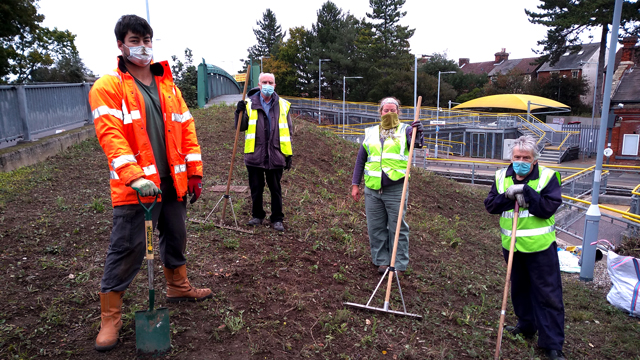
Rail stations in East Anglia are increasingly becoming havens for local wildlife thanks to the efforts of volunteers who have transformed land the equivalent of five Olympic-sized swimming pools into thriving gardens.
Greater Anglia’s team of station adopters – who help to look after their rail stations for the benefit of their communities – increased the total area of station garden across the network by 14% last year and devoted much of it to creating wildlife friendly areas.
In 2020, despite the challenges of the pandemic, the volunteers tended to over 6,400 square metres of railway land and created new gardens or increased the size of existing ones at some locations too, including Brundall Gardens, Chappel and Wakes Colne, Derby Road, Ingatestone, Marks Tey, St Margaret’s and Westerfield.
This is the equivalent of 1.5 acres – or five Olympic sized swimming pools – which will provide habitats for local wildlife as well as making the stations more attractive and welcoming.
In addition, the volunteers almost doubled the number of flower planters on platforms at stations across Norfolk, Suffolk, Essex, Cambridgeshire and Hertfordshire to 454, up from 238 in 2019.
They also installed 61 insect houses and 41 bird boxes.
The gardens, some of which have been developed over many years, are becoming havens for local wildlife populations – with the railway increasingly being recognised by ecologists as a ‘green corridor’ which provides a sanctuary for many different kinds of flora and fauna.
In a recent survey, Greater Anglia station adopters reported a wide range of creatures visiting their stations including many different types of butterflies as well as bees, slow worms, bats, foxes, deer and many varieties of birds, recording over 200 different species.
Greater Anglia’s customer and community engagement manager, Alan Neville, said, “Thanks to the care and attention of our team of station adopters, we have thousands upon thousands of plants thriving at our rail stations which helps not only to make them more welcoming, but are benefiting the environment too.
“Many of these gardens have been designed to be wildlife friendly, enhancing biodiversity and providing food, shelter and breeding places for many different types of wildlife.
“Some of them are becoming really magical places as a result, helping to support rare types of wildlife and benefiting their communities by helping to improve the local environment and existing more harmoniously with their rural surroundings.”
“This is all helping the railway in East Anglia to lead the green recovery from the pandemic by being a much greener way to travel – and our new fleet of trains will contribute even more thanks to their more environmentally friendly features which reduce CO2 and particulate emissions in the region further still and offer a convenient, comfortable alternative to the car.”

